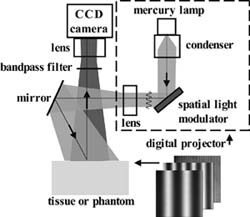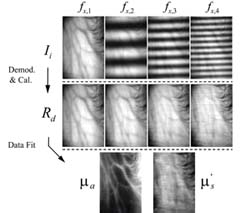
Spatial Frequency Domain Imaging (SFDI) is a wide-field optical diagnostic technique that unlike DOSI, is intended to do a large area interrogation of the target tissue. It shares many of the basic theories with respects to wavelength absorption and scattering but measures them in a different manner utilizing another technique: the projection of modulated spatial-frequencies. By analyzing the spatial modulation transfer function for the diffusion of light within the tissue, both depth and quantifiable optical properties can be extracted for various practical applications including melanoma detection.

Figure 1: Basic engineering design behind SFDI.
Despite the amount of information shown in Figure 1, the basic engineering design behind SFDI is not very complicated. A simple SFDI platform consists of a light source, a digital projector, a CCD camera, and a computer for image-processing. One of the charms of this instrumentation is that all the components can be easily purchased and constructed from commercial grade electronics.

Figure 2: Example data flow for SFDI.
Figure 2 outlines the basic SFDI data flow. The digital projector illuminates the target tissue area with various frequency modulations of a sinusoidal wave. The CCD camera picks up the remitted diffuse light which is then demodulated by a computer in order to extract the diffuse reflectance at multiple spatial frequencies. From this, the 2D absorption and scattering coefficients of the target tissue can be reconstructed using various mathematical models.
John Nguyen 2010
BME 295